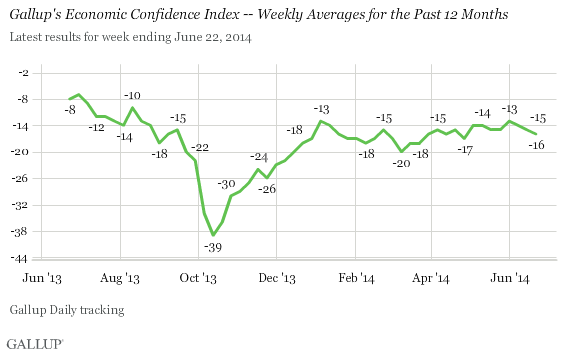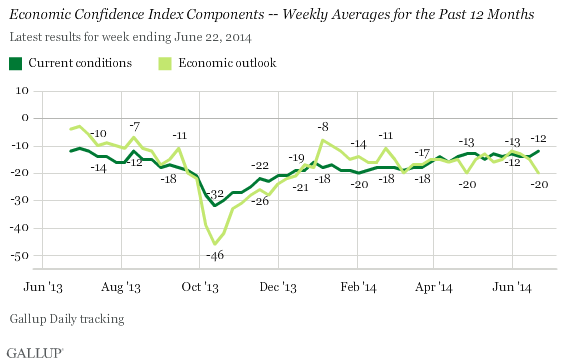WASHINGTON, D.C. -- Gallup's U.S. Economic Confidence Index lost another point last week, the third week in a row the index has dropped by one point. At -16 for the week ending June 22, the index is the lowest it's been since April, although it remains in the narrow six-point range it has stayed within since March -- between -13 and -18.

Gallup's Economic Confidence Index is the average of two components: Americans' views on the current economic situation and their perceptions of whether the economy is getting better or worse. The theoretical high is 100, if all Americans were to say the economy is "excellent" or "good" and that it is getting better; the theoretical low is -100, if all Americans were to say the economy is "poor" and getting worse.
Currently, about one in five Americans (22%) say the economy is excellent or good, while 34% say it is poor, resulting in a current conditions index of -12, which is actually a slight improvement compared with the prior two weeks.
But Americans continue to be less optimistic about the economy's future. Thirty-eight percent say the economy is getting better, while 58% say it is getting worse, for an economic outlook score of -20 -- a five-point drop from the previous week. This is the most negative Americans have been about the economy's future since December 2013.

Americans may be more pessimistic about the future of the economy because of their uncertainties about the situation in Iraq, and whether it might result in higher gas prices. These uncertainties seem to be weighing just a bit more heavily on Americans' minds than the positive news of record stock prices last week.
Bottom Line
Americans may not have shifted much in their perceptions of the economy's current status, but over the past month, they have become more negative about the economy's future.
While these changes may become more pronounced over time, the overall Economic Confidence Index has remained relatively steady in 2014, a contrast to the peaks and valleys sustained last year, especially during the partial government shutdown in October.
Furthermore, the latest weekly reading still sits in the middle of the rather narrow eight-point range in confidence for this year, since the decline began three weeks ago when confidence was on the more positive end of that range.
Survey Methods
Results for this Gallup poll are based on telephone interviews conducted June 16-22, 2014, on the Gallup Daily tracking survey, with a random sample of 3,553 adults, aged 18 and older, living in all 50 U.S. states and the District of Columbia.
For results based on the total sample of national adults, the margin of sampling error is ±2 percentage points at the 95% confidence level.
Interviews are conducted with respondents on landline telephones and cellular phones, with interviews conducted in Spanish for respondents who are primarily Spanish-speaking. Each sample of national adults includes a minimum quota of 50% cellphone respondents and 50% landline respondents, with additional minimum quotas by time zone within region. Landline and cellular telephone numbers are selected using random-digit-dial methods. Landline respondents are chosen at random within each household on the basis of which member had the most recent birthday.
Samples are weighted to correct for unequal selection probability, nonresponse, and double coverage of landline and cell users in the two sampling frames. They are also weighted to match the national demographics of gender, age, race, Hispanic ethnicity, education, region, population density, and phone status (cellphone only/landline only/both, and cellphone mostly). Demographic weighting targets are based on the most recent Current Population Survey figures for the aged 18 and older U.S. population. Phone status targets are based on the most recent National Health Interview Survey. Population density targets are based on the most recent U.S. census. All reported margins of sampling error include the computed design effects for weighting.
In addition to sampling error, question wording and practical difficulties in conducting surveys can introduce error or bias into the findings of public opinion polls.
For more details on Gallup's polling methodology, visit www.gallup.com.
